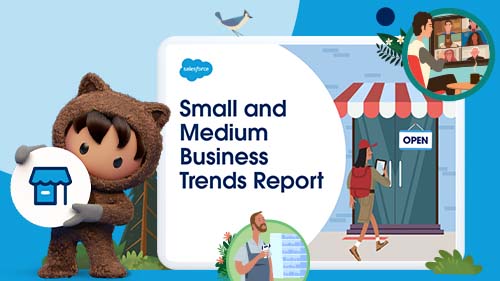As a former small business owner, I know how painful it can be when your business – and therefore your livelihood – hits turbulence. And that was before a pandemic, a time of unprecedented challenge. But SMBs have responded with ingenuity and tenacity.
That’s one reason I’m excited to debut the fifth edition of our Small and Medium Business Trends Report, a survey of over 2,500 SMBs conducted by The Harris Poll. The findings reflect this ingenuity and adaptability, with 89% of SMBs moving a portion of their operations online over the past year and 63% saying they’ve made operational changes in the past year that they expect to provide long-term benefits.
To be sure, the results reflect ongoing challenges. However, along with trends that should inspire hope and optimism, they also reveal differences between stagnant or declining SMBs and growing SMBs (in other words, those that are experiencing revenue growth). These are crucial insights into how to strengthen and grow your own business.
So let’s take a look at what we found.
Local communities step up while SMBs prioritise customer needs
More than one-third of Australian and New Zealander SMBs say local communities’ financial support has been vital to their businesses’ survival.
SMBs don’t appear to be taking that support for granted. Many say they’re taking steps to cater to customer needs and build trust during the pandemic, such as improving flexibility and communication. Over half have increased their presence online and a massive 89% have moved operations online in the past year, listing their number one reason as a desire to serve customers safely.

Still, customer engagement challenges linger. SMBs say their biggest hurdles are bringing innovative offerings to market, keeping up with demand and responding to enquiries quickly.
Embracing a digital-first world comes with its own risks and requirements for building trust, which means SMBs are increasingly turning their attention to better security. Many are using cloud-based technology for data backup and protection, regular application updates, and password managers for stronger passwords.
Employee needs take centre-stage
SMBs aren’t just looking to deepen trust with customers. After many faced rough periods of furloughs or uncertainty, and perhaps with more SMBs recognising the role that employee engagement plays in customer experience, respondents say they’re prioritising employee needs.
This includes building trust through transparency and two-way communication.

Flexible schedules topped employees’ expectations – an expectation that growing SMBs were more likely to meet. These expectations may be impacting where work will occur in the future. While 53% of respondents in Australia and New Zealand say they foresee working from a physical location, 29% expect to work in hybrid or remote environments.
Growing SMBs continue to invest in technology
We know that SMBs have been leaning into technology to protect customers’ safety and improve convenience. The vast majority of SMBs moved at least some of their operations online during the past year, with half saying they’ve moved 51-100% of their operations online and 16% saying they’ve adopted a customer relationship management (CRM) system in the last 12 months.

Continuing a trend from last year’s research, investing in and leveraging technology were differentiators between SMBs who are growing and those who aren’t. More than half (57%) say they would not have survived the pandemic if they had been using technology from a decade ago.
But what sort of technology are they prioritising? The findings show that growing SMBs are significantly more likely to invest in technology for customer service, sales, marketing and IT operations.

Growing SMBs embrace permanent change
After prolonged uncertainty and challenge, many SMBs are finding they’re more efficient than ever. Here in Australia and New Zealand, 63% of SMBs believe the changes they’ve made to their business operations will benefit them long-term. Sixty-nine percent plan to make changes permanent, especially secure digital payments, digital customer service and e-commerce.
They’re also looking beyond immediate challenges. Sixty-four percent have created scenario plans to prepare for future crises, an action that was more likely to be taken by growing SMBs.
There will no doubt be further challenges and disruptions, but SMBs are responding to adversity by becoming stronger, more efficient, more resilient. As savvy SMB leaders prioritise solutions and relationships that fortify their businesses, they’ll be well-equipped to weather whatever may come their way.
Want to dive into the full results?
Download the 5th edition Small and Medium Business Trends Report.




























